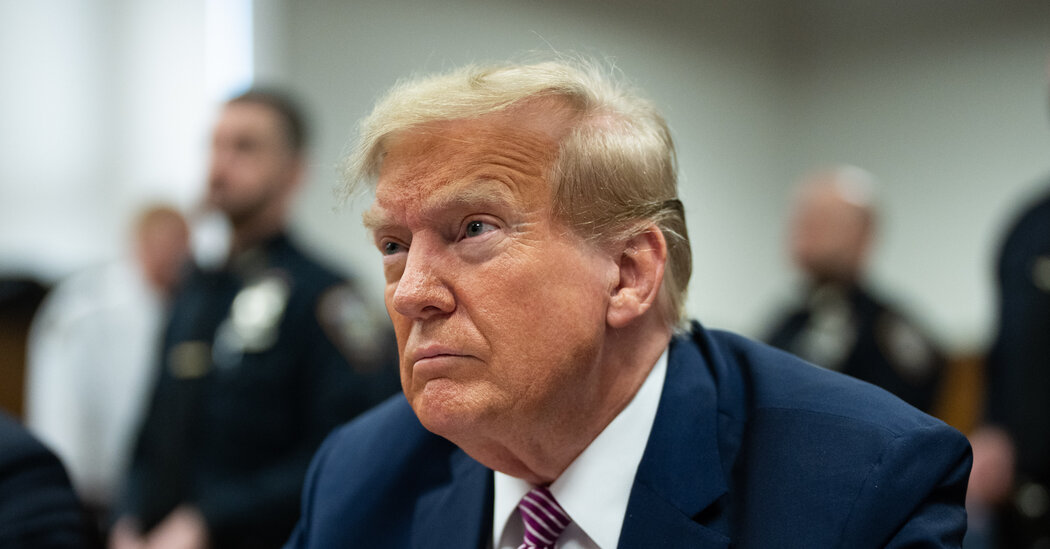The first week of the criminal trial of Donald J. Trump ended with a disturbing jolt: a 37-year-old man set himself on fire outside the courthouse, an event that overshadowed the legal proceedings inside.
The news of the immolation rippled through the press corps just after the final members of Mr. Trump’s jury — including 12 seated jurors and six alternates — were sworn in. Reporters rushed from the Lower Manhattan courtroom.
But the trial’s pace, which has been faster than expected, did not slack. After lunch, Justice Juan M. Merchan conducted a hearing to determine which questions prosecutors might ask Mr. Trump if he were to testify in his own defense.
Mr. Trump, 77, is charged with falsifying 34 business records in an attempt to cover up a payment to Stormy Daniels, an adult film actress who has said they had a sexual encounter in 2006. Prosecutors have said he did so to better his chances of winning the election. He has denied the charges; the former president could face probation or prison if convicted.
Opening statements in the case are expected Monday.
Here are five takeaways from Mr. Trump’s fourth day, and the first week, on trial:
We have our jury. And many are probably familiar with the Lexington Avenue subway.
The process was grueling at times, but we have a panel of 12 Manhattanites who comprise the jury, and six alternates, who will hear the evidence and may be called upon to step in if jurors are excused or disqualified.
It is a diverse bunch, both in their neighborhoods and professions: a Harlem educator, a Chelsea tech worker, a product manager from Upper Manhattan. The alternates who were added Friday included a fashion worker from Chinatown, an information technology specialist from Inwood and an unemployed woman from Murray Hill.
The most heavily represented neighborhood? It seems to be the Upper East Side, with five sitting jurors or alternates.
Trump is almost out of options to stall.
Mr. Trump’s prevailing legal tactic has always been to delay, delay, delay. But on Friday, Mr. Trump’s efforts to forestall next week’s opening statements and subsequent testimony seemed to be running out of gas.
As jury selection concluded, Mr. Trump was losing a bid in an appeals court to pause the proceedings while a full panel of the court could consider a motion to move the trial out of Manhattan.
Justice Merchan also seemed done with efforts to stall the case further, telling defense attorneys in no uncertain terms that he was proceeding with the case on Monday.
Prosecutors seek permission to confront Trump with his legal losses.
Mr. Trump has said that he wants to take the stand, saying that he wants to “tell the truth” and that the prosecution has “no case.” But if he does testify, he will open himself to questions from prosecutors, who cannot otherwise compel him to speak.
On Friday, Justice Merchan held a hearing over what topics prosecutors could question Mr. Trump on were he to testify, including a civil fraud trial in which the New York attorney general won $454 million from the former president after proving he had conspired with others to inflate his net worth. Prosecutors are also asking to bring up a civil jury’s finding last year that Mr. Trump was liable for sexually abusing the writer E. Jean Carroll.
Emil Bove, a lawyer for Mr. Trump, said that introducing questions about the civil fraud trial would take the criminal trial down a “rabbit hole,” and confuse jurors.
Justice Merchan said he would rule Monday, presumably before opening statements.
The immolation shattered the focus on Mr. Trump, if only briefly.
At about 1:35 p.m., just as Justice Merchan was preparing to swear in five alternates, a scene of horror erupted in a small park just across from the courtroom: A man had set himself on fire after throwing leaflets promulgating anti-government conspiracy theories into the air. Onlookers screamed, and bright orange flames engulfed the man.
The man, identified as Max Azzarello, 37, of St. Augustine, Fla., was taken to a hospital and was in critical condition.
The self-immolation, which occurred just behind a battery of television news crews, did the seemingly impossible, temporarily drawing attention away from Mr. Trump’s legal battles.
Later on Friday afternoon, Justice Merchan reconvened court but the reverberations continued. Officials said that many inside the courts were deeply shaken and saddened.
“The entire court is impacted by this,” said Al Baker, a courts spokesman.
The trial was expected to be dramatic. It has lived up to its billing.
There was a crush of reporters at the Manhattan Criminal Courts Building and a defiant and divisive defendant, delivering broadsides against the prosecution and judge as he entered court. There were courtroom clashes and unexpected twists.
The first week of Mr. Trump’s trial did not fail to deliver drama, including a steady stream of potential jurors who said they simply could not be impartial, and lawyers for the defense battling — often unsuccessfully — to get rid of jurors they felt could not be fair. Some potential jurors wept at the thought of being seated on the jury.
For all that, the actual testimony and evidence is still to come in a trial that is expected to take weeks and to include even more electric moments, including Michael Cohen, Mr. Trump’s former fixer, facing his old boss in court. (And testifying against him.)
Ms. Daniels may testify, as may Karen McDougal, a Playboy model who said she, too, had an affair with Mr. Trump. (He denies this too.) Hope Hicks, Mr. Trump’s former communications director, is also on the potential witness list.
All of which suggests that more theatrics could be in the offing.

